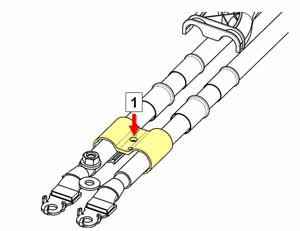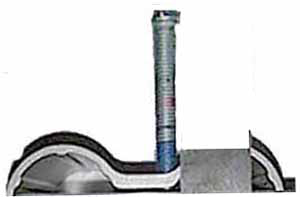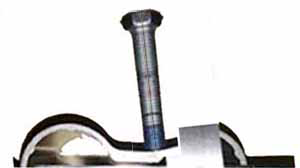Tesla Model S: North America and Japan only: Inspect the shield collar clamp
Tesla Model S (2012-2025) Service Manual / High Voltage System / HV Junction Box - Cover - 2nd Generation (Remove and Replace) / North America and Japan only: Inspect the shield collar clamp
- Insert the HVIL bolt into the shield collar clamp by 2 threads.

1 Install HVIL bolt 2 threads - With the HVIL bolt loosely installed, move the bolt from side to
side. Note whether there is any free play that might indicate
stripped threads in the shield collar clamp.
- If there is minimal free play, the shield collar clamp does
not need to be replaced. Skip to the Installation section of
this procedure.

- If there is significant free play, the shield collar clamp
needs to be replaced. Continue to the next step.

- If there is minimal free play, the shield collar clamp does
not need to be replaced. Skip to the Installation section of
this procedure.
- Inside the HVJB, mark the 2 wires that lead to the charge port as B+ and B-. Caution: Do not reverse the polarity of the cables during reinstallation.
- Inside the HVJB, unbolt the 2 cables that lead to the charge port (torque 9 Nm). Note: It is not necessary to replace the fastener(s) after it is removed. The threaded area has a reusable dry sealant, which looks similar to adhesive patch material.
- Cut the cable ties that secure shield collar clamp
- Replace the shield collar clamp.
- Inside the HVJB, secure the HV cables that lead to the charge port.
- Replace the cable ties that secure the HV cables.
READ NEXT:
 HV Junction Box - Cover - 2nd Generation (Remove and Replace) -
Installation
HV Junction Box - Cover - 2nd Generation (Remove and Replace) -
Installation
Installation
Position the HVJB cover.
Install the HVIL bolt loosely. Do not tighten it fully at this
time.
North America, Japan
Note: In North American a
 HV Junction Box - Reed Switch - 1st Generation (Remove and Replace)
HV Junction Box - Reed Switch - 1st Generation (Remove and Replace)
Note: This procedure only applies to vehicles with the
1st generation High Voltage Junction Box.
Special tools required for this procedure:
Supplier
 HV Rapid Mate Vehicle Side (Remove and Replace)
HV Rapid Mate Vehicle Side (Remove and Replace)
Removal
Remove the HV battery assembly(refer to procedure).
Lower the vehicle, but keep it in position to raise it in a
later step.
Remove the 2nd row seat cushion frame (refer to
SEE MORE:
 Track Mode
Track Mode
Track Mode, available only on Plaid Model S vehicles, is
designed to modify the stability control, traction control,
regenerative braking, and cooling systems to increase
performance and handling while driving on closed
circuit courses. Track Mode improves cornering ability by
intelligently usi
 Seal - Rear Door - LH (Remove and Replace)
Seal - Rear Door - LH (Remove and Replace)
Removal
Remove door trim (refer to procedure)
Release clips (x2) securing flap seal end to door.
Note: Components have been removed in this graphic
to aid clarity.
Caution: Take care not to damage component(s).
Carefully release remai
© 2019-2025 Copyright www.tesms.org

